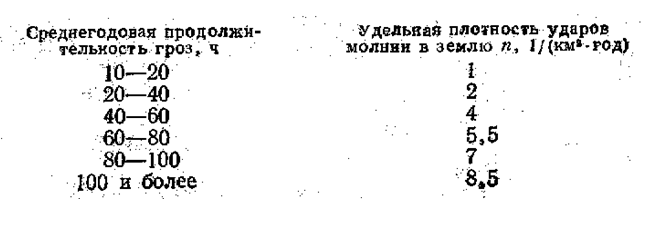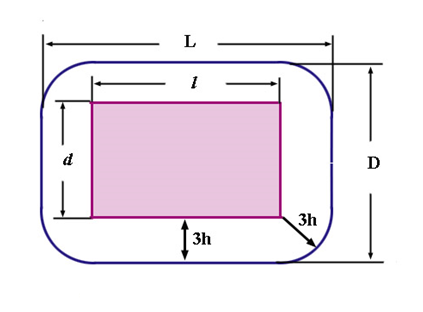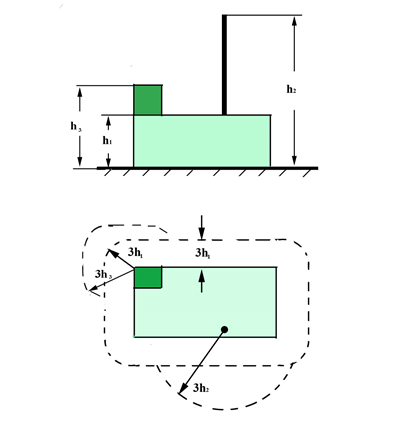From the series of articles "Lightning protection of residential and public buildings - answers to frequently asked questions in the design".
Formally, the calculation is very simple. You need to know the area of the lightning contraction into the building SArticle and their specific density nM in its location. The product of these values gives the average expected number of direct lightning strikes per year:
NM = nMSArticle (1)
In the vast majority of practical situations NM<< 1. Fractional number of lightning has no physical sense. To get a reasonable result, it is necessary to go from the expected number of strokes to the average term of the building use , during which it will take a lightning strike over itself with a probability close to one:
Tlightn. ≈ 1 / NM (2)
All reference materials give the value of nM given per 1 km2 per year. Therefore, the calculated value of Tlightn is measured in years. If, for example, we get NM = 0.03, then you need to averagely expect one lightning strike in 1: 0.03 ≈ 33 years of operation.
The term "averagely" is crucial here. A lightning strike into a particular building is not necessarily going to happen in 33 years. If you are not lucky, it may take only 1 - 2 years before this sad event happens, and perhaps 100 years (for those who are very lucky). The estimated time is really average. It can only be confirmed by long-term statistics of observations after a large number of similar buildings.
Table 1 is taken from the authorizing document AD 34.21.122-87.
Table 1

Среднегодовая продолжительность гроз, ч – average annual duration of storms, h
И более- and more
Удельная плотность ударов молнии в землю – specific density of lightning strikes into the ground
Км в год – km per year
To find the value of nM, you must first turn to the map of thunderstorms durations (the standard contains it too), take the average annual duration of storms for the location of the considered building and then to get the desired nM in Table 1. Needless to say, how approxiate the result will be. I would like to operate with more stringent figures obtained, for example, by thr system of remote recording of thunderstorm intensity with the spatial resolution of at least 200 - 500 meters. Unfortunately, unlike many technically advanced countries, such a system has not been yey deployed in Russia.
It is clear that in this situation it is meaningless to spend great efforts on a strict calculation of the contraction area. According to the experience of observing structures of different heights, it is assumed that it is limited to the line, furthest from the exterior perimeter of the object at a distance equal to its 3 heights. The construction is easy to perform. Then it only remains to calculate a limited area (inside the blue line in Fig.1) by any method, at least - by the cells on the graph paper. With a great uncertainty of nM value, the calculation error of square calculation will hardly be significant.

Figure 1
Elements of a building often have different heights. In this case the contraction radius can be estimated by the height of the highest element. The result of the expected number of strokes will give an estimation from the top. For a more accurate calculation it is necessary to build areas for all building elements of different height and make their common external border, as shown in Fig. 2. The area reserved by it will give a revised contraction area for the whole building.

Figure 2
The constructions made are only valid for private buildings. Adjacent buildings or tall trees can greatly change the result. Imagine the area of urban development or a gardening co-operative, where the houses are very close to each other. Their lightning contraction zones partially overlap. As a result, the expected number of strokes in each house will be less. At comparable height of neighboring buildings it can be considered that the superposed sections of the lightning contraction zone are equally split between the houses. If their heights are fundamentally different, and their contraction zones overlap in significant proportion, it is necessary to resort to computer calculations. It is also necessary to do so in case when the customer requires great accuracy.
In practice, the need of a defined calculation is rare. Estimation of the number of lightning strikes for a detached building can be always regarded as ultimate, and the error even at the level of a significant figure is quite acceptable due to a rough estimate of density of lightning strikes on the territory of Russia.
In the end of this section I will bring the characteristic values for a preliminary rough orientation, provided that the specific density of lightning is equal to nM = 4 per km2 per year:
E. M. Bazelyan, DEA, professor
Energy Institute named after G.M. Krzyzanowski, Moscow
Read more "Remote effects of lightning".
Useful materials:
- Series of articles about lightning protection for beginners
- Series of webinars about grounding and lightning protection with Professor E. M. Bazelyan
- Elements of external lightning protection
- Consultations on the selection, design and installation of grounding and lightning protection systems
Related Articles:



